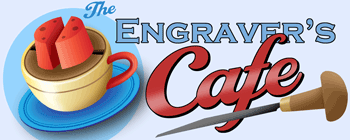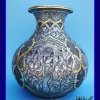First I want to thank you for your kind comments,
Ok, let me explain the process now, at first I should mention that the vase itself without any engraving is a handicraft! Some other masters in our city (Isfahan) make vases, bowls, … with their tools, that is they make these artworks from sheets of copper only by special hammers and their hands! That is truly amazing, and we need them for this type of work because the vase, cylinder, … must be uniform and It must not be cracked through the process, for example the vase that you saw earlier does not have any hole or crack on its surface or through its patterns,
The next step is that a painter draws the patterns on the vase with a marker, then we fill the vase with pieces of melted and hot tar, you should be very careful here and in the next steps, because if you don't have the skill, the vase explodes! Then with special chisels we hit borders of patterns,and then we hit the background of the vase until the patterns start becoming embossed, the vase should remain symmetrical and fine, after a lot of engravings with about 50 different chisels, we fire the vase until the tar melts and begins coming out of the vase, and then we fire the vase itself until the remaining tar inside the vase burns to ash, we wash the vase with some acid and other materials, and then another important level is to smooth the background and patterns with chisels without the tar inside the vase, and after a few other steps for making the vase shiny and …. It will be finished, but notice that it is not such a simple work, and there are also levels that I has not mentioned here and the whole work is complicated and demands a very highly skilled artist,
Thank you for reading my post and at the end I put a picture of one of my masters working on another vase about a few years ago at their decent workshop!,
(Please informed me if you did not understand any part of my explanation, you know I am not an expert at English language, thank you )

Ok, let me explain the process now, at first I should mention that the vase itself without any engraving is a handicraft! Some other masters in our city (Isfahan) make vases, bowls, … with their tools, that is they make these artworks from sheets of copper only by special hammers and their hands! That is truly amazing, and we need them for this type of work because the vase, cylinder, … must be uniform and It must not be cracked through the process, for example the vase that you saw earlier does not have any hole or crack on its surface or through its patterns,
The next step is that a painter draws the patterns on the vase with a marker, then we fill the vase with pieces of melted and hot tar, you should be very careful here and in the next steps, because if you don't have the skill, the vase explodes! Then with special chisels we hit borders of patterns,and then we hit the background of the vase until the patterns start becoming embossed, the vase should remain symmetrical and fine, after a lot of engravings with about 50 different chisels, we fire the vase until the tar melts and begins coming out of the vase, and then we fire the vase itself until the remaining tar inside the vase burns to ash, we wash the vase with some acid and other materials, and then another important level is to smooth the background and patterns with chisels without the tar inside the vase, and after a few other steps for making the vase shiny and …. It will be finished, but notice that it is not such a simple work, and there are also levels that I has not mentioned here and the whole work is complicated and demands a very highly skilled artist,
Thank you for reading my post and at the end I put a picture of one of my masters working on another vase about a few years ago at their decent workshop!,
(Please informed me if you did not understand any part of my explanation, you know I am not an expert at English language, thank you )









